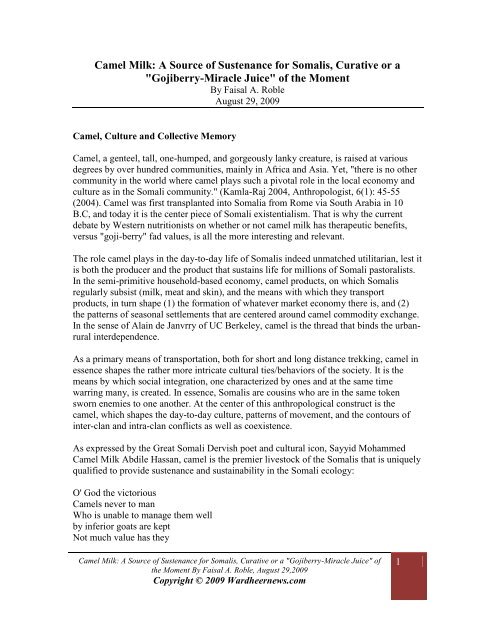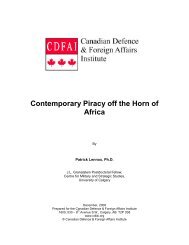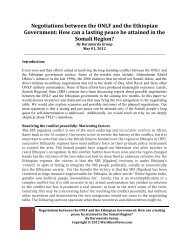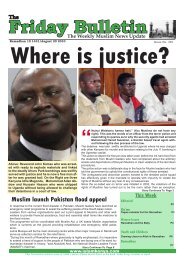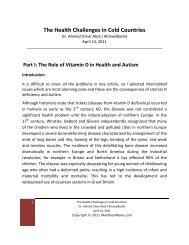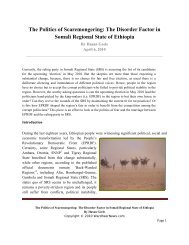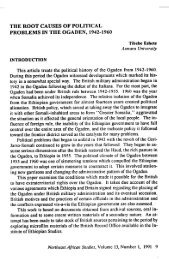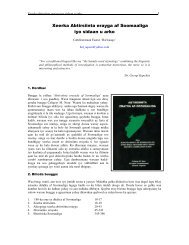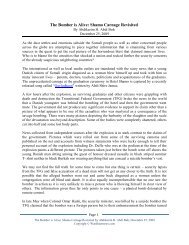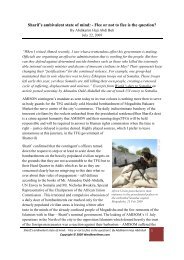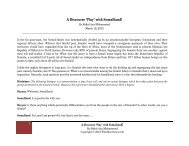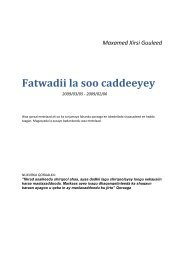The Two Filthy Ponds: Beel & Extreme Religion - WardheerNews
The Two Filthy Ponds: Beel & Extreme Religion - WardheerNews
The Two Filthy Ponds: Beel & Extreme Religion - WardheerNews
You also want an ePaper? Increase the reach of your titles
YUMPU automatically turns print PDFs into web optimized ePapers that Google loves.
Camel Milk: A Source of Sustenance for Somalis, Curative or a<br />
"Gojiberry-Miracle Juice" of the Moment<br />
By Faisal A. Roble<br />
August 29, 2009<br />
Camel, Culture and Collective Memory<br />
Camel, a genteel, tall, one-humped, and gorgeously lanky creature, is raised at various<br />
degrees by over hundred communities, mainly in Africa and Asia. Yet, "there is no other<br />
community in the world where camel plays such a pivotal role in the local economy and<br />
culture as in the Somali community." (Kamla-Raj 2004, Anthropologist, 6(1): 45-55<br />
(2004). Camel was first transplanted into Somalia from Rome via South Arabia in 10<br />
B.C, and today it is the center piece of Somali existentialism. That is why the current<br />
debate by Western nutritionists on whether or not camel milk has therapeutic benefits,<br />
versus "goji-berry" fad values, is all the more interesting and relevant.<br />
<strong>The</strong> role camel plays in the day-to-day life of Somalis indeed unmatched utilitarian, lest it<br />
is both the producer and the product that sustains life for millions of Somali pastoralists.<br />
In the semi-primitive household-based economy, camel products, on which Somalis<br />
regularly subsist (milk, meat and skin), and the means with which they transport<br />
products, in turn shape (1) the formation of whatever market economy there is, and (2)<br />
the patterns of seasonal settlements that are centered around camel commodity exchange.<br />
In the sense of Alain de Janvrry of UC Berkeley, camel is the thread that binds the urbanrural<br />
interdependence.<br />
As a primary means of transportation, both for short and long distance trekking, camel in<br />
essence shapes the rather more intricate cultural ties/behaviors of the society. It is the<br />
means by which social integration, one characterized by ones and at the same time<br />
warring many, is created. In essence, Somalis are cousins who are in the same token<br />
sworn enemies to one another. At the center of this anthropological construct is the<br />
camel, which shapes the day-to-day culture, patterns of movement, and the contours of<br />
inter-clan and intra-clan conflicts as well as coexistence.<br />
As expressed by the Great Somali Dervish poet and cultural icon, Sayyid Mohammed<br />
Camel Milk Abdile Hassan, camel is the premier livestock of the Somalis that is uniquely<br />
qualified to provide sustenance and sustainability in the Somali ecology:<br />
O' God the victorious<br />
Camels never to man<br />
Who is unable to manage them well<br />
by inferior goats are kept<br />
Not much value has they<br />
Camel Milk: A Source of Sustenance for Somalis, Curative or a "Gojiberry-Miracle Juice" of<br />
the Moment By Faisal A. Roble, August 29,2009<br />
Copyright © 2009 Wardheernews.com<br />
1
for in droughts severe<br />
worthless goats are<br />
no better cattle are<br />
without maintenance constant<br />
it is Goha that life sustains<br />
O' pride of the home<br />
antelope-like she-camel<br />
noblest of animals all surely she<br />
the furry-necked she-camel<br />
with belly huge<br />
sour milk abundant produces she<br />
you, curly-furred camel of mine... (Ahmed Ali Abokor, Uppsala,1987)<br />
How Somalis move around with their camels, where they water or graze them, deeply<br />
shapes patterns of ecologically sustainable transhumance. It is often the case that clans<br />
whose camels come in contact with each others' in the many wells of Walwaal and<br />
Ciid(Haro Ciideed) forge visible intermarriages and cultural integrations which tame<br />
conflicts that could have otherwise turned much more deadlier.<br />
<strong>The</strong> water wells of Walwaal were at the turn of the last century the focal point for water<br />
supply for camels in the Danood region that housed several heavily intermarried Somali<br />
clans who had fought wars while at the same time mending fences. It is in this context<br />
that the epic poems of Guba, which ended up pitting Ali Dhuuh, versus Salaan Carabay,<br />
Versus Qamaan Bulhan were individuals who were all related to one another in one way<br />
or another was instigated by a causal conflict on a popular camel watering point in the<br />
vicinity of Walwaal.<br />
So central camel is to Somali existentialism that the late president of Somalia, Abdi-<br />
Rashid Ali Sharmarke, once said of camel poetry (or pastoral verse) to be "one of two<br />
National assets of inestimable values" for Somalis, and is only paralleled in importance<br />
by Islam. Thus, God and Camel are praised in the same verse exclusively sung for camels<br />
to coax them to drink water:<br />
God, men and camels are prayed to<br />
for their bounties limitless….<br />
No wonder, then, that camel occupies an enviable position of mythic proportions in<br />
Somali politics, poetry and culture that it in turn largely defines the very being of<br />
Somaliness. Despite a handful of up starter revisionists within the Somali studies<br />
community that denounces the camel culture as an invading force, or, often as they call it,<br />
the "Dervishization" of the Somali society, this "furry-necked, belly-huge" animal centers<br />
the totality of the Somali being - his harsh ecology, his desires for possessions and in<br />
Camel Milk: A Source of Sustenance for Somalis, Curative or a "Gojiberry-Miracle Juice" of<br />
the Moment By Faisal A. Roble, August 29,2009<br />
Copyright © 2009 Wardheernews.com<br />
2
what stock, his metaphysical and existential values are all expressed in camel stock.<br />
Thus, Abdi Gahayr raises camel status, Somali's sustainable source for sustenance, to a<br />
level of religion, and has aptly articulated his peopl's deep affection of it beyond mere<br />
superlatives. His closing verse of his famous camel approbation poem has been<br />
romanticized by all Somalis:<br />
Aakhiro nimaan geel lahayn, lama amaanayne<br />
Idin-Bacaso awrkey dhashiyo, aarankay wadatay,<br />
wa ilal ibili kuma soo dageen, aayadaha diine<br />
aakhiro nimaan geel lahayn, lama amaanayne.<br />
<strong>The</strong> baby calf of Idin Bacaso, that male camel she mothered as well,<br />
are they not praised in the verses of Koran,<br />
are they not benefited the prophet soldiers,<br />
men without camel weren't admired in the hereafter world.<br />
In the words of Ali Eilmi Afyare and M. Qaasin, two powerful contemporary poets, the<br />
close-to-heart she-camel, otherwise "Mandeeq," the mother of tranquility, or the Sayyid's<br />
"Goha" euphemistically stands for nationhood and its sustenance; it is the ultimate<br />
symbolism thorough which public discourse of any sort is engaged. For example, Ali<br />
Elmi Afyare, in expressing his disillusionment with post-independence government of<br />
Somalia, a myopically corrupt government that lasted from 1960 to 1969, caricatured the<br />
smashed hopes of his society to a "Mandeeq" that went stray:<br />
.....when maaandeeq the camel beloved<br />
abundant milk produced for all<br />
few people drunk all of it<br />
not once but many times more<br />
disappointing the hungry and the brave<br />
who for the camel fought hard for long..... (Ahmed Ali Abokor, Uppsala, 1987)<br />
Somalis take camel images and its symbolism to wherever they go. In the new world, a<br />
she-camel portrait is found in Somali neighborhoods be it in Cedar, Minneapolis,<br />
(Minnesota), or in Winona, San Deigo (California). <strong>The</strong> image of a larger-than-life, oversized<br />
she-camel poster that has been a permanent fixture since the 1950s on a the better<br />
part of one of the walls of the the Somali Section of the BBC, for example, is symbolic of<br />
the Somali Diaspora's resolve to bring Somali identity into the heartland of its old<br />
colonial ruler. After all, one of Britain’s Colonial officers in the Haud and Reserve one<br />
Smith was lambasted with stern verses when he confiscated thousands of camels owned<br />
by "belligerent" clans:<br />
Isma oga Ismiid iyo ninkii ayro foofsadaye<br />
Isma oga Agoon iyo ninkii aabaheed dilaye<br />
Unaware of each other are Smith and those blessed with Ayro (camel)<br />
Camel Milk: A Source of Sustenance for Somalis, Curative or a "Gojiberry-Miracle Juice" of<br />
the Moment By Faisal A. Roble, August 29,2009<br />
Copyright © 2009 Wardheernews.com<br />
3
unaware of each other are the orphan and that one who committed the murdering. <strong>The</strong><br />
latest country where camel symbolism is to be imported to is the Nordic country of<br />
Norway. Wenche Stenseth, head of the refugee section at Loeten in southern Norway,<br />
said the local authority has applied for one million crowns ($149,100) from the<br />
Norwegian Directorate of Immigration for a feasibility study of a camel farm that might<br />
start with 10-20 of the humped animals. We're trying to think in new ways," Stenseth told<br />
Reuters. "This is about exploiting the skills people have." About 100 refugees, including<br />
people from Somalia and Sudan, live in Loeten, a village about 120 km (75 miles) north<br />
of Oslo. But, one may ponder, what about the medical benefits to be extracted from<br />
camel and its milk!<br />
Camel Milk: A Curative or a "Goji-berry-miracle" Juice?<br />
<strong>The</strong> issue of the inherent curative attributes to camel milk is not new. In fact, Somali<br />
literature is abound with versus and songs about the linkage between camel milk and<br />
person's health and wellbeing:<br />
....without a full belly<br />
of your milk nourishing<br />
strength and stamina mine<br />
forever I lose<br />
helpless a man to become .... (Ahmed Ali Abokor, Uppsala, 1987)<br />
But are the healing properties of camel milk all myth, or can they be proved and therefore<br />
provide a bright future for camel dairying? Barry Popkin, the Carla Smith Chamblee<br />
Distinguished Professor of Global Nutrition at the UNC Chapel Hill School of Public<br />
Health, said the health claims for camel's milk or any nutritional credit bestowed on it are<br />
"largely unfounded." Popkin, without hesitation, adds the claim of camel milk curing a<br />
number of diseases is "the goji-berry-miracle juice of the moment."<br />
However, other scientist maintains that anti-infection, anti-cancer, anti-diabetes benefits<br />
of camel milk are real and attainable. Dr. Bernard Faye of the France-based research<br />
organization CIRAD (Centre de cooperation international en recherché agronomique<br />
pour le développement) catalogues areas of diseases where camel can help; and these are<br />
diabetes, tuberculosis, stomach ulcers, gastro-enteritis, cancer, etcetera. Bold claims these<br />
as may be, researchers have found preliminary scientific basis for some of the claim it<br />
cures. As a result, one could already see that "the medical sector is very interested in the<br />
immunoglobulin of camel milk." Immunoglobulin is the substance in the camel milk that<br />
contributes to immunity against infection," says Dr. Hinkle.<br />
As to the curative benefits of camel milk, diabetes is less contentious. With camel milk<br />
consumption, “some kind of insulin replacement therapy appears to be taking place,” says<br />
Dr. Rajendra Prasad Agrawal, associate professor of medicine at the S. P. Medical<br />
College in Bikaner and principal investigator of an authoritative study, who began his<br />
Camel Milk: A Source of Sustenance for Somalis, Curative or a "Gojiberry-Miracle Juice" of<br />
the Moment By Faisal A. Roble, August 29,2009<br />
Copyright © 2009 Wardheernews.com<br />
4
study of the effect of camel milk on patients with diabetes about five years ago. In the<br />
first study, he picked 24 young patients with type I diabetes, all below the age of 30<br />
years. <strong>The</strong> doctors divided the patients into two groups — 12 patients received the<br />
standard treatment which included diet, exercise, and insulin injections, and the other 12<br />
received 500 ml of raw camel milk each day in addition to the standard treatment. <strong>The</strong><br />
standard treatment for insulin-dependent diabetes, also called Type I diabetes, involves<br />
diet, exercise and insulin injections. <strong>The</strong> group that received 500 ml. of raw camel milk<br />
requirement reduced their insulin dependence in some patients by about 30 per cent.<br />
“<strong>The</strong>re is something in camel milk that behaves like insulin,” says Dr Rajendra Prasad<br />
Agrawal."<br />
<strong>The</strong> prospect of a cure-all is what inspires Dr. Hinkle, a naturopathic physician who read<br />
about the health benefits in a magazine three years ago and decided to lead a national<br />
drive for approval of camel milk in the United States. "We have great hope for it," Dr.<br />
Hinkle said, noting that regulatory approval would enable producers to conduct scientific<br />
studies and give the milk some bona fides.<br />
Responding to a growing interest in the curative aspect of camel milk and camel<br />
products, Faisal Roble of <strong>WardheerNews</strong> went directly to Dr. Hinkle, the most outspoken<br />
proponent for the curative benefits of camel milk and conducted the following interview<br />
to learn more whether Somali's lanky and huge-belly animal, whose sour milk sustained<br />
life for many millenniums, has curative or "goji-berry miracle juice" benefits.<br />
WDN: Let me ask you the first question about yourself: How did you become interested<br />
in studying camels?<br />
Dr. Hinkle: I became interested in the effects of the camel milk after reading a small<br />
article about the health benefits for allergies in children. I began the quest to get the milk<br />
into the US for sale.<br />
WDN: How would you describe your research work, and how long have you been doing<br />
it and who is supporting you?<br />
Dr. Hinkle: I have been in practice for approximately 25 years and have been doing the<br />
research with the camel milk for the last 3 years. I am totally supporting all the research<br />
so far by myself but am now having to look for investors because the milk is getting so<br />
big here with the demand by so many people. I am working now on a study that compares<br />
the effects of the raw milk vs. the effects of the pasteurized milk on patients with autism<br />
and diabetes.<br />
WDN: What are the major findings of your research about camel milk that your work on<br />
so far? Do you only study camel milk in the Somali inhabited regions of the Horn of<br />
Africa or there are other regions that you would cite?<br />
Camel Milk: A Source of Sustenance for Somalis, Curative or a "Gojiberry-Miracle Juice" of<br />
the Moment By Faisal A. Roble, August 29,2009<br />
Copyright © 2009 Wardheernews.com<br />
5
Dr. Hinkle: I rather like to do my studies in the US and therefore do not study in Somalia<br />
but have had many demands by Somali citizens here in the US for the milk. <strong>The</strong>y want it<br />
for themselves and for their children. <strong>The</strong>re is such a high rate of autism in the US with<br />
the Somali population that it is in great demand.<br />
WDN: Tell us about your efforts to introduce camel milk into the U.S. and how it was<br />
received by the scientific community and federal agencies such as Food and Drug<br />
Administration (FDA)?<br />
Dr. Hinkle: I had a law changed to allow the camel milk to be sold in the US and the<br />
FDA approved a law to allow the milk to be sold. Although it is not available for the<br />
market just yet because we have to design kits to test the milk for pathogens and then we<br />
will test the milk with the kits. This is coming along nicely and we should be able to see<br />
milk available within the next 6 to 10 months. <strong>The</strong> scientific community here in the US is<br />
very interested in the milk and doing studies with the milk. We have recently supplied<br />
milk to a large university here in the US to study the effects of the camel milk on the<br />
neurotransmitter levels in the brain. This is important because it could replace many of<br />
the drugs with the terrible side effects for such things as autism, depression, and<br />
Parkinson disease.<br />
WDN: In your estimation, how long would it take, if at all, for camel milk to appear on<br />
grocery store shelves in the U.S.?<br />
Dr. Hinkle: I expect the milk to be available within the next 6 to 10 months for sale in<br />
certain areas and for mass sale within the next 12 to 16 months.<br />
WDN: For those who want to support efforts to introduce camel milk in the U.S., what is<br />
the best way to help?<br />
Dr. Hinkle: Obviously we need financial support or donations to help with the expense<br />
of the legal work to get the milk into the US and for the cost of getting the labs to speed<br />
up their work. I have spent my entire life saving on this. I am not in this for profit but just<br />
to make the milk available to the people of the US and for people in all the other<br />
countries who have contacted on me. I am also working with Canada and several other<br />
countries like Singapore, Thailand, and Europe to make the milk available but this is an<br />
expensive process to meet all the legal demands for the licensing and the permits and the<br />
testing. It is also very time consuming but we are making great progress. I want to thank<br />
all the kind and caring Somali people here in the US and around the world who have<br />
contacted me and hope to have good news soon<br />
Faisal A. Roble,<br />
Email: Fabroble@aol.com<br />
Wardheernews.com, editorial board<br />
Camel Milk: A Source of Sustenance for Somalis, Curative or a "Gojiberry-Miracle Juice" of<br />
the Moment By Faisal A. Roble, August 29,2009<br />
Copyright © 2009 Wardheernews.com<br />
6


